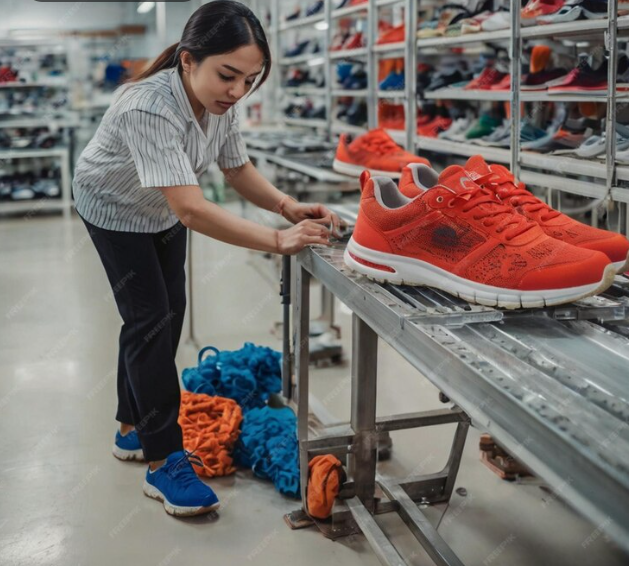- Empty cart.
- Continue Shopping
Key Factors to Consider When Choosing Safety Shoes

Workplace hazards, fatal or non-fatal, are events with a higher occurrence rate. According to a 2022 report by the U.S. Bureau of Labor Statistics (BLS), the rate of non-fatal workplace injuries and illnesses was 2.7 cases per 100 full-time workers. The same body reported over 5,000 fatal workplace injuries in the U.S. in 2021. Slip, trip, and fall incidents, foot injuries, and electrical hazards play a major part in these occurrences. This is exactly where the relevance of safety boots comes into the spotlight.
Safety shoes or work shoes are essential personal protective equipment (PPE) that are designed to safeguard feet from different workplace hazards. They come with reinforced toes to protect against impact and compression, Slip-resistant soles, and materials that protect feet from chemicals, punctures, and other electrical hazards.
With these many features, these mens work boots find application in diverse industries from construction to warehousing where workers are exposed to foot injuries. However, choosing the right safety shoes is still a conundrum for many. The following sections are helpful with some key factors to consider in such purchases.
- Material
The material determines the durability, protection, and comfort offered by these shoes. Leather, synthetic materials like nylon and polyester, and composite materials are the common materials in use.
- Leather: When it comes to durability leather has an upper hand. A study published in the “Journal of Occupational Health” shows that leather safety shoes have a 30% higher durability rate compared to synthetic alternatives in heavy industrial settings.
Experts also opine that it has a perfect balance of durability, breathability, and protection making them ideal for diverse work environments.
- Synthetic Materials: Synthetic safety boots made from materials like nylon and polyester offer lightweight, flexible, and durable protection. They also offer effective protection against chemicals, abrasions, and punctures.
- Composite Materials: These include non-metallic safety shoe materials like carbon fiber or plastic. As characteristic of composite materials they offer strong protection while ensuring lightweight and comfort.
The choice between these materials depends on industry-specific requirements.
- Size
According to the American Podiatric Medical Association (APMA), ill-fitting footwear causes 60% of foot injuries in the workplace. This underscores the need to select the correct size of safety shoes.
Tips to Select the Right Size:
- Ensure to measure both feet. Because they could differ in size.
- Consider trying the shoes at the end of the day. This is a time when the feet are usually swollen. This ensures that the shoe is comfortable in extreme circumstances.
- Also, make sure that the selected mens work boots give enough space for free movement of toes while giving sufficient support for the ankles.
- Model
Studies such as the one published in the “Safety Science” journal show that workers using model-specific safety shoes have experienced a 25% reduction in foot-related injuries compared to those using generic models.
Here are some models to consider while getting safety boots:
- Steel Toe Boots: They provide top-notch toe protection and ankle support. They are also characterized by durable leather uppers, slip-resistant soles as well as designs to withstand impact and punctures. This makes them ideal for construction and heavy-duty work.
- Low-cut Safety Shoes: These work shoes are lightweight variants that offer greater flexibility and movement. Nevertheless, they offer essential protection which makes them ideal for industrial work, warehousing, and service industries.
- Lace-Up Safety Shoes: Here we have safety boots that are adjustable for a snug fit. Since they come in low-cut and boot models they are ideal for a range of industries.
- Slip-On Safety Shoes: The Slip-On varieties as the name indicates offer ease in frequent removal and wearing. They come with no laces to tie. Such access facilitates an environment where workers need to frequently remove and put on their shoes.
- Sole Material
The sole material of work shoes is something that determines their slip resistance, durability, and comfort.
Common sole materials include:
- Rubber Soles: Durability, slip-resistance, and resistance to abrasions and chemicals are the characteristics that make them popular. Moreover, they offer strong traction on wet and oily surfaces. They are also known for their flexibility and shock absorption.
- PU Soles: PU or Polyurethane is an expert-recommended material for safety boots, especially if they are used in jobs that require extended standing or walking. Because they offer excellent comfort and reduce foot fatigue.Their durability, shock absorption, and resistance to chemicals, oils, and abrasives also add to the qualities that make them appealing.
- TPU Soles: Thermoplastic Polyurethane (TPU) soles combine the features of rubber and polyurethane sole materials. That is, they offer high abrasion resistance and flexibility. Moreover, they offer excellent grip and durability, making them ideal for demanding work environments.Other than these options Ethylene Vinyl Acetate (EVA) soles and Nitrile soles are also often used for mens work boots. Experts opine that the right sole materials ensure that the safety shoes provide the necessary grip, cushioning, and longevity for specific work environments.
- Other features to look for in safety boots
- Toe Protection: This is essential to protect the toes from falling objects or compression. Steel, composite, and aluminum are the common types of toe protection. The choice depends on the specific workplace hazards and the level of protection that it demands.
- Slip Resistance: Work environments prone to spills, wet conditions, or that have surfaces like tile and metal require safety shoes with high slip resistance. This reduces workplace injuries due to falls or slips.Soles designed with deep treads and specific patterns that enhance grips are highly recommendable in this direction. Material choices as mentioned in the earlier sections could also help.
- Electrical Hazard Protection: EH protection helps workers exposed to electrical risks. Typically such work shoes have non-metallic and non-conducting materials in heals and soles. EH ratings and popular standards such as ASTM can also be used while selecting such shoes.
- Puncture Resistance: This is an important factor, especially for workplaces that expose workers to sharp objects. Studies show that a puncture-resistant shoe reduces injuries from sharp objects by about 60%.
In this direction consider soles with a protective layer made from steel or composite textiles embedded in the midsole. Such protective layers prevent the penetration of sharp objects and thus help maintain a safe working environment.
- Comfort: Comfort is pivotal in safety boots to prevent foot fatigue and long-term musculoskeletal issues. Cushioned insoles, breathable materials, and ergonomic designs are recommendable in this direction.
If there are options like laces in these work shoes to ensure customized fit to individual preferences it will be like a cherry on the icing. Thus overall employee wellbeing can be ensured.
- Durability: Durable safety shoes are cost-effective with minimal replacements. Other than material and model choices it is advisable to look for mens work boots that come with a sturdy make and reinforced stitching.
Thus we have covered the key aspects to consider while purchasing safety shoes. Now it is time to find a supplier that delivers variety and quality. Hygiene For All is the best e-commerce store that can be relied on in this direction. Visit our online stores to see it for yourself.







